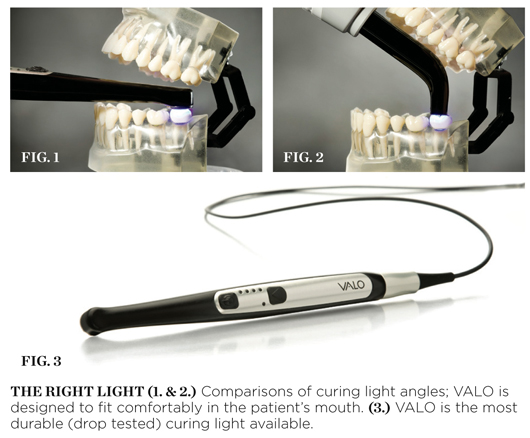VALO: The Right Power in the Right Place
Despite the long history of dental curing lights, there are still challenges that impact the curing process: power density, light dispersion, and temperature, to name a few.
In addressing power, curing light manufacturers need to balance several characteristics in their designs. Historically, it has been nearly impossible to do this, but the engineers who developed VALO have achieved the best possible results in each area, providing balance without compromise (Figure 1, Figure 2, Figure 3).
The Right Power
The factors that affect curing light power are: power density, beam collimation, beam uniformity, spectral distribution, and light transmission through composite.
Power Density
Also called irradiance or light intensity, power density is usually expressed as mW/cm2. VALO’s engineers found the ideal tip diameter for its custom LED pack. VALO was created with three different modes: Standard Power, High Power, and Plasma Emulation Mode.
Beam Collimation
With refined optics that create excellent light collimation, VALO maintains intensity over a greater range of distances, allowing the clinician consistent, high-quality results at any normal working distance.
Beam Uniformity
Non-uniform output causes “hot spots” or “cool spots,” which result in inconsistent curing across the restoration. VALO solves this problem with specialized optics, producing consistent results regardless of the restoration type, size, or location.
Spectral Distribution
With its custom LED pack, VALO produces light that provides uniform curing throughout the restoration, as well as three peak wavelengths or colors of blue (an industry first), allowing it to cure all dental materials, including proprietary photointiators and camphorquinone.
Light Transmission
When light hits composite, its reaction depends on the composite’s hue, refractive properties, filler type, volume, and translucency/opacity. While VALO cannot control variations in composite, it can compensate for these variations through its appropriate selection of wavelengths (colors) and power distribution to penetrate standard layers of composite to achieve a maximum cure.
The Right Place
Several factors affect proper curing light position, including: light guide design, beam angle, location and restoration type, distance between the restoration and the light guide, and ability to stabilize the curing light during the procedure.
Light Guide Design
The distance the average male adult mouth opens drops to 30 mm when working in vivo.1 To accommodate such a limited working space, VALO’s wand-style body was designed without a light guide, allowing the clinician to properly position the curing light in all areas of the mouth, without discomfort to the patient.
Beam Angle
VALO’s wand-style design, along with the 5° angle of its head, enables the practitioner to position the tip directly over the restoration site with a 0° beam angle.
Location and Restoration Type
The location of many in vivo restorations makes proper curing light positioning almost impossible, especially when using a curing light with an oversized head or the traditional “angled” light guide. VALO’s low profile design and sleek body enables proper placement, even for children or patients with limited opening capability.
Distance
It is not easy to maintain a specific distance from the restoration when working in vivo, where the typical proximal box is ~7 mm and best practices call for holding the tip of the curing light 2 mm from the preparation surface.2 With its low profile, wand-style design, and ergonomically correct construction, VALO significantly reduces the possibility that the practitioner will experience distance and offset issues.
Construction
VALO’s uni-body construction from a single rod of high-grade, aircraft caliber aluminum makes it is the most durable (drop tested) curing light available. VALO’s custom LED chip is not overpowered, unlike other LED curing lights on the market, and will therefore run efficiently and maintain its brightness for life. Powered by a thin, flexible, Kevlar-impregnated cord (rather than batteries, which power most LED curing lights), VALO eliminates concerns about battery life and the cost of replacements.
References
1. Calder I, Picard J, Chapman M, et al. Mouth opening: A new angle. Anesthesiology. 2003;99 (4):799-801.
2.Gerrit RM, Claus-Peter E, Willershausen B. Decrease in power output of new light-emitting diode (LED) curing devices with increasing distance to filling surface. J Adhes Dent. 2002;4(3):197-203.
For more information, contact:
Ultradent Products
Phone: 801-552-5512
Web: www.valo-led.com
Disclaimer
The preceding material was provided by the manufacturer. The statements and opinions contained therein are solely those of the manufacturer and not of the editors, publisher, or the Editorial Board of Inside Dentistry. The preceding is not a warranty, endorsement, or approval for the aforementioned products or services or their effectiveness, quality, or safety on the part of Inside Dentistry or AEGIS Communications. The publisher disclaims responsibility for any injury to persons or property resulting from any ideas or products referred to in the preceding material.







